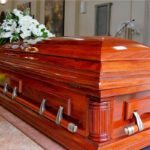Starbucks has a new market, death. A store recently opened in a funeral home outside Dallas, Texas. Meanwhile, in Massachusetts, food is banned in funeral homes, but legislators are trying to push through a law that would legalize it.

Some Texas funeral homes are now serving Starbucks. While five states still ban food in funeral homes eating and death are age-old. At one point in history “parts” of the dead themselves were eaten, as portrayed in the 2007 film, “The Last Sin Eater”.
But the state is an outlier, only four others prohibit food in funeral homes; Connecticut, New York, New Jersey and Pennsylvania. For the most part, food is an inseparable part of the funerary tradition.
The type of food eaten varies. “Recently we had a lovely funeral dinner,” explained a Wisconsin mortician named Joseph Becker in a 2005 New York Times article. “Beautiful china and linen. Fancy folded napkins. Sculpted butter. A fabulous display of hors d’oeuvres. Chicken on a skewer with a nice Greek dressing. Stuffed mushroom caps. Little Reuben sandwiches.” For a German family, Becker did a baked chicken dinner with parsley boiled potatoes, green beans and relish trays. For a Norwegian lady he served Swedish meatballs. In the South, funeral dishes might include a casserole, or a Jell-O salad. At March Funeral Home in Baltimore the funeral meals are substantial: fried chicken, string beans, ham, potato salad, pig tails cooked with sauerkraut and for dessert, chocolate sheet cake, sweet potato pie and apple pie.
FUNERAL CUSTOMS ACROSS CULTURES AND RELIGIONS
Hindus, on the 13th day after a death, will eat a vegetarian meal of curry and sambar, cooked without garlic or onions. Three traditional desserts are eaten; appam, a rice-flour pancake, vada, a kind of doughnut and payasam, a rice pudding sometimes cooked with cardamom powder, saffron mixed in milk and cashews fried in clarified butter. The focus on dessert is significant, sweetness allows for people to carry on with their lives.
Muslims often eat a meal of lamb, rice and bread. An especially common dish is mansaf, a way of cooking lamb in a sauce made with dried yogurt. Occasionally, the sauce is richened with buttermilk or cilantro. Beside the lamb, on a big stainless steel tray, is served flatbread with rice and almonds and pine nuts that have been fried in olive oil.
“Funeral feasts in traditional societies often constitute the single most important and costly event in the history of a family,” says archaeologist Brian Hayden, who in 2009, published a paper entitled, Funerals as Feasts: Why are they so important? “Not only are enormous amounts of time and resources spent for no apparent material benefit,” continues Hayden, “but in many ethnographic cases, families actually become destitute in their obsession to hold impressive funeral feasts.” His paper is a cross-cultural synthesis on early funeral feasts. Hayden argues that funeral feasts had political and socioeconomic underpinnings; they created an arena for political alliances to be borne and helped to reaffirm the wealth of top families in societies where wealth and power were constantly in flux.
WEIRDEST FUNERAL FEAST: 70 TORTOISES, 3 AUROCHS & A LEOPARD PELVIS
Other archaeologists believe funeral feasts had more ritualistic roots, serving to gain the deceased access to a good afterlife or flattering the dead so that they’d be inclined to bring wealth back to the living from the beyond. Sometimes it was “parts” of the dead themselves being eaten. William Howlett describes the act of sin-eating in an essay entitled, “Wakes, Mutes, Wailers, Sin-Eating, Totemism, Death-Taxes”. Savage tribes have been known to slaughter animals on the grave in the belief that they would take up the sins of the dead, Howlett explains. In the same manner, the human sin-eater ingested the sins of the dead by eating food placed on the tomb of the deceased. The sin-eater was regarded to be associated with evil spirits and witchery and was only sought out when there was a death. His meal often included a loaf of bread and a maga-bowl of maple. After he consumed it the wooden bowl and platter from which he had eaten was burned. For his services he received about six cents.
The job was a less than desirable one. “Abhorred by the superstitious villagers as a thing unclean, the sin-eater cut himself off from all social intercourse with his fellow creatures by reason of the life he had chosen,” says Howlett. “He lived as a rule in a remote place by himself, and those who chanced to meet him avoided him as they would a leper.” Sin-eating is the basis of the 2007 film, “The Last Sin Eater”, which describes an 1850s Appalachia community of Welsh Americans descended upon by Christian preachers.









